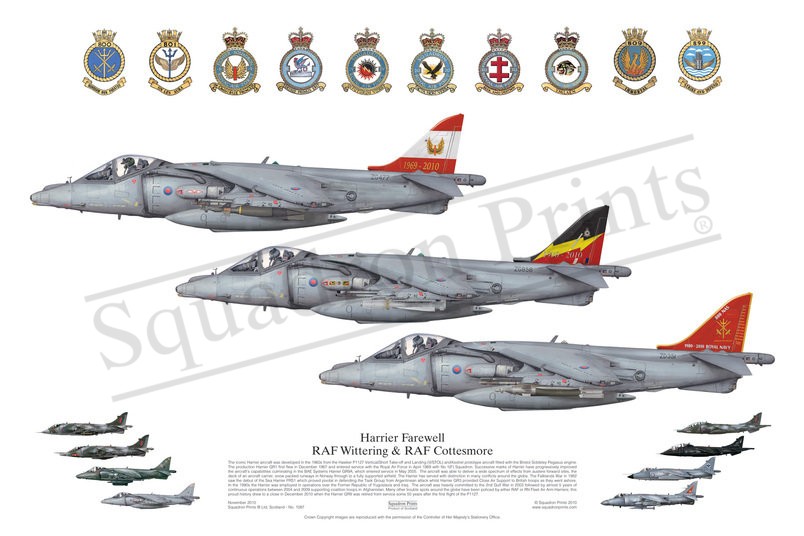#1087CU Harrier Farewell

Description
Squadron Prints Lithograph No. 1087CU - Harrier Farewell, RAF Wittering & RAF Cottesmore. Harrier GR9, ZG477, 1(F) Squadron, ZG858, 4(F) Squadron and ZD351, 800 Naval Air Squadron. The iconic Harrier aircraft was developed in the 1960s from the Hawker P1127 Vertical/Short Take-off and Landing (V/STOL) and Kestrel prototype aircraft fitted with the Bristol Siddeley Pegasus engine. The production Harrier GR1 first flew in December 1967 and entered service with the Royal Air Force in April 1969 with No 1(F) Squadron. Successive marks of Harrier have progressively improved the aircraft’s capabilities culminating in the BAE Systems Harrier GR9A, which entered service in May 2005. The aircraft was able to deliver a wide spectrum of effects from austere forward sites, the deck of an aircraft carrier, snow packed runways in Norway through to a fully supported airfield. The Harrier has served with distinction in many conflicts around the globe. The Falklands War in 1982 saw the debut of the Sea Harrier FRS1 which proved pivotal in defending the Task Group from Argentinean attack whilst Harrier GR3 provided Close Air Support to British troops as they went ashore. In the 1990s the Harrier was employed in operations over the Former Republic of Yugoslavia and Iraq. The aircraft was heavily committed to the 2nd Gulf War in 2003 followed by almost 5 years of continuous operations between 2004 and 2009 supporting coalition troops in Afghanistan. Many other trouble spots around the globe have been policed by either RAF or RN Fleet Air Arm Harriers; this proud history drew to a close in December 2010 when the Harrier GR9 was retired from service some 50 years after the first flight of the P1127.
You may also like
-
36 FS, F-16CM Fighting Falcon print
88-0536 '36 FS'36 FS, 51 FWOsan AB, Republic of Korea -
SALE 2019 Typhoon Display PVC Spearhead Patch 1000+
29 Sqn; Typhoon DisplayRAF Coningsby
